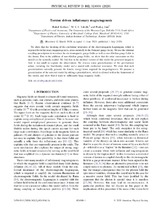| dc.contributor.author | Kothari, Rahul | |
| dc.contributor.author | Saketh, M. V. S. | |
| dc.contributor.author | Jain, Pankaj | |
| dc.date.accessioned | 2021-02-15T09:39:22Z | |
| dc.date.available | 2021-02-15T09:39:22Z | |
| dc.date.issued | 2020 | |
| dc.identifier.citation | Kothari, R. et al. (2020). Torsion driven inflationary magnetogenesis. PHYSICAL REVIEW D, 102(2), 024008 | en_US |
| dc.identifier.issn | 2470-0029 | |
| dc.identifier.uri | 10.1103/PhysRevD.102.024008 | |
| dc.identifier.uri | http://hdl.handle.net/10566/5925 | |
| dc.description.abstract | We show that the breaking of the conformal invariance of the electromagnetic Lagrangian, which is required for inflationary magnetogenesis, arises naturally in the Poincaré gauge theory. We use the minimal coupling prescription to introduce the electromagnetic gauge fields as well as non-Abelian gauge fields in this theory. Due to the addition of non-Abelian gauge fields, we show that the solar constraints on this model can be naturally evaded. We find that in the minimal version of this model the generated magnetic field is too small to explain the observations. We discuss some generalizations of the gravitational action, including the Starobinsky model and a model with conformal invariance. We show that such generalizations naturally generate the kinetic energy terms required for magnetogenesis. We propose a generalization of the minimal model by adding a potential term, which is allowed within the framework of this model, and show that it leads to sufficiently large magnetic fields. | en_US |
| dc.language.iso | en | en_US |
| dc.publisher | American Physical Society | en_US |
| dc.subject | Electromagnetic Lagrangian | en_US |
| dc.subject | Torsion driven | en_US |
| dc.subject | Inflationary magnetogenesis | en_US |
| dc.subject | Non-Abelian gauge fields | en_US |
| dc.title | Torsion driven inflationary magnetogenesis | en_US |
| dc.type | Article | en_US |

